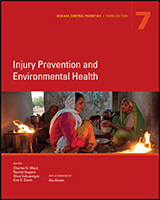The fields of injury prevention and environmental health address diverse health problems that arise from exposure to outside forces, such as chemicals and other toxins, infectious agents, kinetic energy, and thermal energy. The health problems addressed by these fields include the following:
Unintentional injuries, such as road traffic accidents, falls, burns, and drowning
Intentional injuries, such as interpersonal violence
Diseases, such as those caused or aggravated by exposure to airborne and waterborne pollutants
Occupational hazards, such as injuries and diseases caused or aggravated by workplace toxins,
Effects of climate change due to human greenhouse emissions, such as enhancement of waterborne infectious diseases.
The conditions and risks encompassed in these fields account for more than 12 million deaths per year—21 percent—of the annual global total of 56 million deaths.
Most of these conditions and risks have not been effectively addressed globally; in recent years, however, some have received increased attention. This Injury Prevention and Environmental Health volume of Disease Control Priorities, third edition (DCP3), contributes to the understanding of how to address these health problems in the following ways:
Elucidating the health burden of these conditions
Documenting trends in the health burden at different phases of national development
Identifying the most cost-effective and cost-beneficial interventions
Describing policies and platforms that can widely and effectively deliver these interventions.
This volume looks at several types of policy approaches to reduce the burden of ill health from environmental and occupational risks and injuries. Unlike the other DCP3 volumes, most of the actions proposed in this volume speak directly to non-health sectors, where a substantial portion of disease and injury prevention policies and programs needs to occur. These actions include fiscal and intersectoral policies, such as taxes and subsidies; regulations; and policies that affect infrastructure, the built environment, and product design. Also included are information, education, and communication initiatives to promote behavioral changes; these initiatives leverage a range of vehicles, from mass media campaigns to one-on-one counseling. A second major difference from other DCP3 volumes is that the economic evidence supporting the actions described in this volume is primarily benefit-cost analyses—the benefits and costs may occur outside of the health sector and must be accounted for in common monetized units. We include two extended cost-effectiveness analyses (ECEAs) that indicate policies that provide strong financial risk protection for individuals and households.
Most of the policies and interventions discussed in this volume have not been fully implemented in high-income countries (HICs); their implementation in low- and middle-income countries (LMICs) is substantially more incomplete. More complete implementation would help to reduce the disproportionately high rates of death and disability from these conditions in LMICs. Doing so could avert over seven million premature deaths annually from environmental and occupational exposures and injuries in LMICs.
The goal of the editors and authors of Injury Prevention and Environmental Health is to provide the requisite evidence-based rationale and guidance to increase implementation of effective strategies to prevent injuries and lower environmental risks in countries at all economic levels. We hope to stimulate increased implementation of proven effective strategies that have not yet been applied widely, let alone universally. We also seek to focus attention on the need to identify new strategies that would be particularly effective in LMICs. Finally, we wish to highlight the potentially substantial health hazards of climate change. This particular environmental issue will likely become increasingly preeminent in the 21st century. The resultant health problems, including food and water insecurity, may rival those of other major risk factors. The toll could be especially tragic among the world’s poorest people. Enhancing the understanding of climate change and identifying effective interventions are likely to become major challenges in the next generation.
We thank the following individuals who provided valuable comments and assistance to this effort: Elizabeth Brouwer, Kristen Danforth, Mary Fisk, Rumit Pancholi, Jinyuan Qi, Shamelle Richards, and Carlos Rossel. The authors also thank the reviewers organized by the National Academy of Medicine and the InterAcademy Medical Panel listed separately in this volume. We especially thank Brianne Adderley for her hard work in keeping this large endeavor well organized.
Charles N. Mock
Rachel Nugent
Olive Kobusingye
Kirk R. Smith

